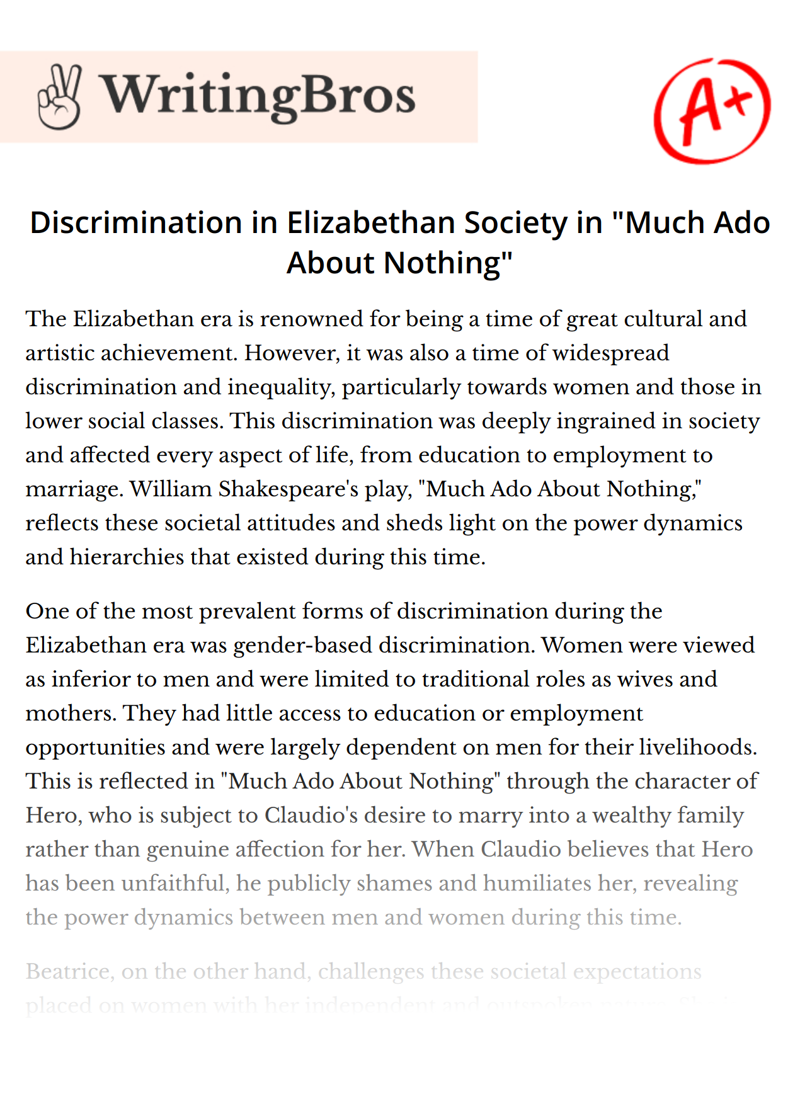Discrimination in Elizabethan Society in "Much Ado About Nothing"

The Elizabethan era is renowned for being a time of great cultural and artistic achievement. However, it was also a time of widespread discrimination and inequality, particularly towards women and those in lower social classes. This discrimination was deeply ingrained in society and affected every aspect of life, from education to employment to marriage. William Shakespeare's play, "Much Ado About Nothing," reflects these societal attitudes and sheds light on the power dynamics and hierarchies that existed during this time.
One of the most prevalent forms of discrimination during the Elizabethan era was gender-based discrimination. Women were viewed as inferior to men and were limited to traditional roles as wives and mothers. They had little access to education or employment opportunities and were largely dependent on men for their livelihoods. This is reflected in "Much Ado About Nothing" through the character of Hero, who is subject to Claudio's desire to marry into a wealthy family rather than genuine affection for her. When Claudio believes that Hero has been unfaithful, he publicly shames and humiliates her, revealing the power dynamics between men and women during this time.
Beatrice, on the other hand, challenges these societal expectations placed on women with her independent and outspoken nature. She is portrayed as strong and intelligent, but even she is subject to the patriarchal system. Her eventual marriage to Benedick reinforces the power dynamics between men and women, showing that even a strong and independent woman cannot escape the constraints of her gender and social status.
In addition to gender-based discrimination, the Elizabethan era was also marked by discrimination based on social class. The aristocracy held most of the power and wealth, while those in lower classes had little say in their lives and were often forced to work menial jobs to survive. The lower classes had limited access to education and opportunities for advancement, and their futures were largely determined by their social status.
This is reflected in "Much Ado About Nothing" through the character of Dogberry, the head constable, who is portrayed as bumbling and incompetent in contrast to the more refined and educated aristocratic characters. Similarly, Don John, the villain of the play, is depicted as bitter and vengeful due to his lower social status.
Despite the progress that has been made since the Elizabethan era, discrimination based on gender and social class still exists today. Women continue to face unequal treatment and barriers to opportunities and advancement. Furthermore, those in lower social classes still struggle to achieve social mobility, and their futures are often determined by their socioeconomic status.
It is crucial to continue the fight against discrimination and work towards greater equality for all. This means challenging the societal norms and attitudes that perpetuate discrimination and advocating for policies and practices that promote fairness and opportunity. We must recognize that discrimination based on gender and social class is interconnected, and both must be addressed in order to achieve true equality.
In conclusion, "Much Ado About Nothing" reflects the discrimination prevalent during the Elizabethan era, particularly towards women and those in lower social classes. The play sheds light on the power dynamics and hierarchies that existed during this time and serves as a reminder of the progress that still needs to be made. By recognizing the interconnectedness of discrimination based on gender and social class and advocating for change, we can create a more just and equitable society.
Cite this Essay
To export a reference to this article please select a referencing style below

